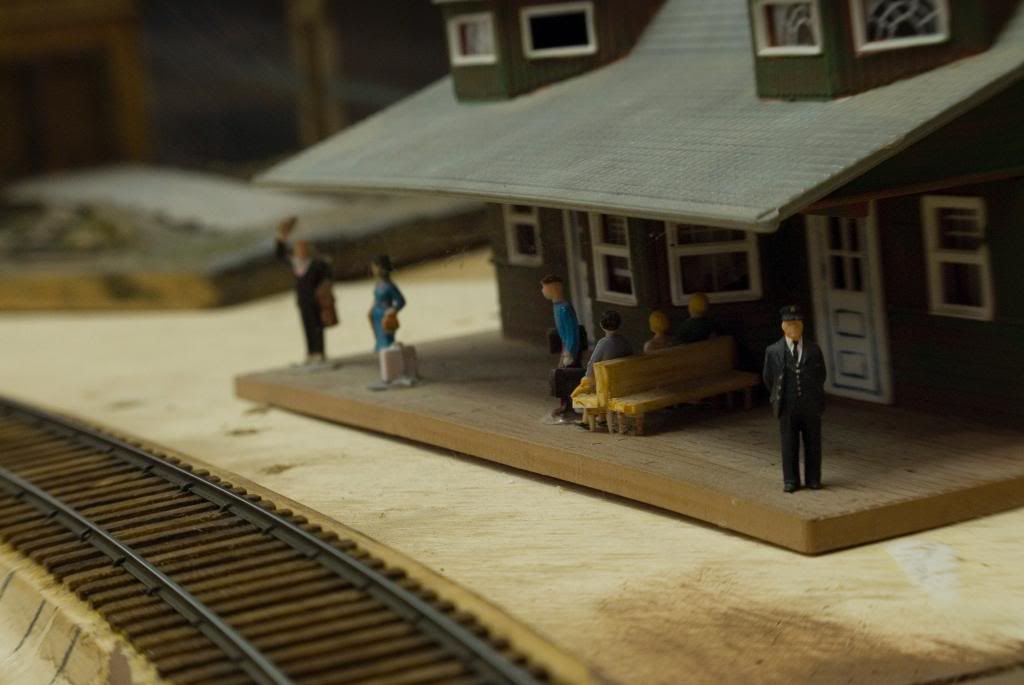Inquiring minds and all that.
Creosote is out because I hate the smell.
Inquiring minds and all that.
Creosote is out because I hate the smell.
I like Minwax Black Walnut wood stain. It looks a lot like aged creosote. A 1/2 pint will do a lot of ties for about $5.
When I wanted to have a bunch laying alongside the tracks, I’d drop a number of 'em in a bottle of ink. Can’t get much more instant results than that !
I’ve got 2000 ties. What’s the best way to stain them? Dunk them in a tea strainer?
Maybe put them in a zip loc bag with your stain and slosh them around. Pour them out through a strainer. Probably best to do this outdoors and in old clothes (or your birthday suit). It will be messy!
Buy wood stain (suitable for staining furniture) and some thinner at the hardware/paint store. Cut off the top of an empty milk carton partially fill with a thinned mixture of stain. (Experiment with ratio for desired darkness using a few ties. Start 50/50 ratio.) Dump about 100 ties at a time, stir, then remove when desired darkness achieved. Take out in stages for more variation among ties. Spread out on a newspaper to dry. Do this all outdoors, and don’t kick over the carton to avoid staining patio or killing plants.
Mark
Old English makes a furniture touch up stain that comes in different colors. Works great for staining wood and most grocery stores carry it.
Those that have suggested staining the ties first have forgotten that you will need to sand the ties smooth and flat after you’ve glued them down. So, you’ll need to stain them again. The sequence I was taught years ago was to glue the ties down first, sand smooth and flat, then stain and lay rails.
Properly stained ties carry the color into the ties’ interiors. With a smooth roadbed, quality ties, and a bit of care laying the ties, I find that little sanding is needed. If after sanding there are objectionable light spots, touch up with some stain.
Mark
Dump them into a glass jar full of alcohol and a dropperful of India ink (this is not a precise measurement, nor does it need to be). The result looks great, especially if you don’t do them all at once for the same length of time, so they come out different shades. (Note: Most prototype RR ties are NOT brown, they are varying shades of grey, so his works well to duplicate that.)
If you sand them, you’ll find they come out looking even better than straight out of the dip.
Do this far from an open flame or cigarette.
Mark
Those that have suggested staining the ties first have forgotten that you will need to sand the ties smooth and flat after you’ve glued them down. So, you’ll need to stain them again. The sequence I was taught years ago was to glue the ties down first, sand smooth and flat, then stain and lay rails.
[#ditto]
What I have done in the past (which is the old club way to do it) is to use brown liquid shoe polish (either with a sponge applicator tip or applied with solder brushes). Lay the ties bare, sand them, etc. After that, hit them with the polish. It gives them that dark, greasy look that real creosote has.
Paul A. Cutler III
Weather Or No Go New Haven
Along with walnut stain, I make like 5-10% of my ties grey using IPA with india ink to have some “old” ties in the mix…
Brian
Several posts have noted the difficulty in getting an even absorption of stain due to irregular sanding.
As a woodworker, I use dyes. TransTint is my favorite, and is normally diluted with alcohol so it will not raise the grain --that is to say, you will not need to sand again or at all.
Dyes, unlike stains which are absorbed, are surface pigments and distribute color evenly despite sanding or lack thereof. Unlike paints which are opaque and so cover the wood grain, dye pigments are nearly molecular in size, so the wood still looks like wood.
Wear latex gloves or else your fingers will be stained for days. Anyone remember Rob Petri and the rain cloud costume? Anyway, I apply dyes using old t-shirts.
Both with stains and with dyes, the way to limit unintended absorption at the end grain (which will suck up liquids like a straw), the trick is to sand the ends of a piece using at least 200 grit. Since you are after a creosote look, end grain absorption should not be an issue with either method.
By-the-way, the shoe polish method in the previous post works very well - I have seen the results but not used it myself. However, on shoes and boots, as the wax dries, it does tend to lighten the color and dull. For my boots… I use dyes. Really!
Crews
My experience using dyes in the 1960s was that they corroded the spikes because of their salt content. I don’t know if dyes necessarily contain salt, but that was my experience. So, I moved to stains. I’ve not tried laying unstained ties because my experience with gluing wood first is that when glue is misplaced, it prevents the absorbtion of stains and dyes. The method I previously described worked. Anyway, that has been my observation.
Mark
I’ve got 2000 ties. What’s the best way to stain them? Dunk them in a tea strainer?
It’ll work. I once put two and a half dozen tea bags in a glass jar, added about three cups of water, let stand for twenty-four hours, strained thoroughly, and then added a couple of hundred switch ties - Northeastern 1/32 by 3/64 stripwood cut to length - and let soak for about four hours. They had swelled ever so slightly and needed minor sanding after I had them glued to my cork but they looked like . . . . . . . . . . wood that had been soaked in tea which is about what ties look like. Were I to use this method again I would use either more tea bags or less water and cut my tie-soak time back to probably two hours in the hopes that I could eliminate any sanding.
My current method is a 1:1:2 DARK brown boot polish, DARK gray boot polish, 91% alcohol mixture. I add a couple of hundred ties to this mixture and it comes out looking like . . . . . . . . . . wood that has been soaked in tea which is about what ties look like.
Chip,
I agree with the staining after glueing and sanding ties. The old method of the walnut Old English does give a great initial look, however, the oil dries out and leaves very little pigment in/on the wood tie. Before ballasting, I always need to come back and hit the ties w/ Minwax walnut staion. Since we use Wather’s Shinahara flex in combination with hand laid, blending the track/ ties is a little more challenging. Mainline ties are done darker to show well kept trackwork. At some turnouts I’ll show even newer looking ties to show recent maintainance. Sidings, especially older or rarely used will be faded and even showing aged silver/ graying of the ties. Yards are very dark and oil stained at well used leads and trackage.
This just laid area shows the stained ties (right) that the Old English has faded. The Narrow gauge to the left is completed/ ballasted yard track that is showing the dark stained ties and cinder/ dirt ballast.

This shows a transition of the flex and hand laid, track to right is flex to hand laid sw. Mainline change is at the tower.

Fresh stained ties doctored with Minwax, no weathering yet.

A tie jig can be made easily for placing the wood ties. It is just a 1x with wood spacers to place the ties at tie spacing. you place a strip of 1/2 or 3/4" masking tape on the ties and lift them off ready to glue down.
Stains vary. Use what you can duplicate. I used Min Wax stain.
I made a Dunker / Strainer out of window screen that would fit in the can and “sewed” it together with small gauge wire. I then stirred up the stain, put the strainer in the can, then added the ties. They will want to float, so you have to push them down. Then you can pick up the strainer, shake it a little, and dump the ties on newspaper to let them dry and move on to the next batch.
Wow!
I don’t think I’ve seen such a range of disparate advice. I’m hoping that it’s a case of all tracks lead to Grand Central Station.